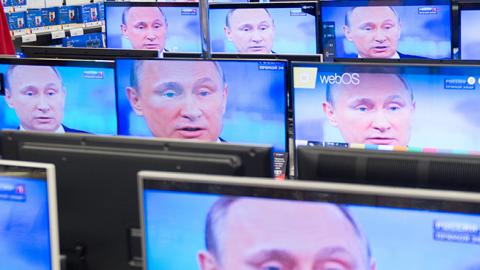Since Russia began its adventure in Ukraine in spring of 2014, eastern Europeans have become particularly sensitive to the Russian-controlled media that is allowed to operate freely in their countries. The Kremlin made good use of its media weaponry in Russian-speaking Crimea and Donbas, convincing Crimeans that fascist Kyivans were on their way to slaughter them, and telling the citizens of Donbas about the horrifying abuses that the Ukrainian government was afflicting on children a few miles away.
The Baltic countries, which have sizeable ethnic Russian populations, have been working to prevent similar scenarios from occurring in their own countries by developing their own Russian-language media content. But they are fighting an uphill battle. In Latvia, where 27 percent of the population is ethnic Russian, Kremlin-controlled television programs are broadcast from Russia every day and reach over half of the non-Latvian population and nearly 30 percent of the ethnic Latvian population.
In Estonia, where 25 percent of the population is ethnic Russian, the reach of Kremlin-controlled television stations is less, but their market share nationwide is around 24 percent. In September 2015, the Estonian government launched ETV+that broadcasts predominately in the Russian language. But the channel, which the government says is not designed to gain huge ratings, has struggled to gain viewers and there is evidence that suggests most are actually ethnic Estonians, not the targeted Russians.
But neither country has been deterred and indeed appears to be determined to succeed with their Russian language broadcasting experiments.
For its part, the Latvian public broadcasting system’s LTV7 debuted a 23-minute Russian-language children’s show—the first of its kind in the European Union. A kind of nascent Bill Nye the Science Guy, Laboratory of Miracles (Laboratoria Chudes) is set in a laboratory where Vyacheslav Kashcheyev, a physics professor at the University of Latvia, his assistant Julia, and a robot named Oskar conduct science experiments and report on themes like firefighters and recycling.
Produced by Latvians and filmed at the AHHAA Science Museum in Tartu, Estonia, Laboratory of Miracles is the first locally-produced children's program in the Baltics. In the past, children's programming in the Baltics has been imported from the West or Russia, and dubbed into the local language.
Laboratory of Miracles broadcasts on Saturday mornings and the creators of the show hope that their show, which is targeted to children aged seven to twelve, will also be watched by other members of the family. What it may lack in production value is made up for in the quality of its graphics and, most importantly, fascinating experiments. The show has been quite popular in its first months, the result of which is an additional Sunday morning airing.
For various historical, socio-economic, cultural, and geographic reasons, some within the ethnic Russian community have lived separately from the ethnic Latvian and Estonian populations and have felt excluded by those governments. The Estonian and Latvian governments see these new Russian-language programming initiatives as both a continuation of their countries’ ongoing efforts to integrate the Russian-speaking population, as well as an improvement on their current Russian-language programming which consists largely of boring news programs as compared to the higher quality educational and entertaining content broadcast by the Kremlin.
At the same time, clearly the Baltic governments want to provide their Russian-speaking populations with an alternative to the Kremlin-directed media that they have traditionally relied upon. Amid very plausible reports that entire networks of Baltic-focused Russian-language news and entertainment websites are secretly connected to the Kremlin, projects like Laboratory of Miracles are increasingly important.
Should Laboratory of Miracles—still in its early days—prove a success, its potential to be exported to other former Soviet nations with large Russian-speaking populations would appear self-evident. Or, of course, similar programs could be produced in those local environments.
For its part, the United States and Radio Free Europe/Radio Liberty has begun a new 24- hour Russian language channel called Current Time or Nastoyaschye Vremya that focuses on news and investigative reportage which, while useful, is of marginal entertainment value. So, while US-supported fact-based content should compete—especially where Kremlin-sponsored broadcasts have a monopoly—no one in Washington should forget that entertainment programs receive the bulk of viewership.
It’s essential that homegrown edu-tainment television programming initiatives like Laboratory of Miracles be recognized for their success and value, and be appropriately prioritized by relevant US funding agencies and organizations that support other countries’ efforts to integrate minorities. Besides doing the good work of bridging historical divides within these countries, it’s essential to deny the Kremlin an information monopoly especially outside its borders—whether in Estonia and Latvia, or Ukraine and Kazakhstan—where too often realities are distorted and manipulation of facts can quickly become a security threat.













